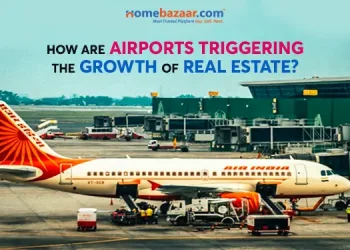Page Contents
Importance Of Expressways In India
With its vast and diverse landscape, India has witnessed a paradigm shift in its transportation infrastructure over the years.
Among the transformative elements contributing to this evolution, expressways have emerged as crucial arteries of connectivity, playing a pivotal role in reshaping the nation’s transportation landscape.
These high-speed, controlled-access roadways connect major urban centres and serve as catalysts for economic growth and regional integration.
Homebazaar.com’s AVP Dharmesh Thakkar said in a recent discussion about the pivotal role of expressways in transforming India’s infrastructure landscape.
He said, “These high-speed corridors not only significantly reduce commute times between major cities but also foster regional connectivity, making our properties more accessible and enhancing the overall quality of life for our homeowners. The strategic development of expressways is instrumental in driving economic growth, improving logistics, and creating vibrant communities, aligning seamlessly with our vision for a connected and thriving India.”
Expressways in India stand as a symbol of progress, connectivity and efficiency in the modern era.
These well-designed road networks, often characterised by limited access, high speeds, and advanced traffic management systems, have become integral components of the country’s transportation ecosystem.
As a stark departure from traditional roadways, expressways prioritize seamless travel, reduce congestion, and improve safety, addressing the evolving needs of a rapidly developing nation.
Significance of Expressways in Fostering Economic Development and Connectivity
 The impact of expressways extends far beyond the realm of transportation. These modern thoroughfares serve as conduits for economic development, connecting key industrial and commercial hubs.
The impact of expressways extends far beyond the realm of transportation. These modern thoroughfares serve as conduits for economic development, connecting key industrial and commercial hubs.
By significantly reducing travel time and enhancing connectivity, expressways facilitate the efficient movement of goods and people, bolstering trade and commerce.
The enhanced connectivity, in turn, stimulates regional development, attracting investments, and creating employment opportunities along the expressway corridors.
In this article, we delve into the multifaceted role of expressways in India, exploring their historical evolution, current significance, technological advancements, economic and social implications, as well as prospects.
By understanding the transformative power of expressways, we aim to unravel the intricate interplay between infrastructure development, economic progress, and national connectivity in the Indian context.
Current National Expressways in India Network
Here is a list of expressways in India.
| Expressways | Length | State | Speed Limit |
| Delhi-Meerut Expressway | 96 Km | Delhi & Uttar Pradesh | 70 kmph in Delhi, 100 kmph in Ghaziabad and 120 kmph between Dasna and Meerut. |
| Ahmedabad – Vadodara Expressway | 93 Km | Gujrat | 80 kmph |
| Mumbai-Vadodara Expressway | 1,380 Km | Gujarat & Maharashtra | 120 kmph |
| Eastern Peripheral Expressway | 135 Km | Hariyana & Uttar Pradesh | 120 kmph |
Under Construction National Expressways in India
There are 7 expressways under construction in India. Here is a list of them,
| Expressways | Length | State | Speed Limit | Completion Date |
| Delhi-Mumbai Expressway | 1,350 Km | Delhi, Rajasthan, Haryana, Gujarat, Madhya Pradesh, and Maharashtra | 120 kmph | Dec 2024 |
| Bangalore-Chennai Expressway | 258 Km | Karnataka and Tamil Nadu | 120 kmph | Dec 2025 |
| Delhi-Nakodar-
Amritsar- Katra Expressway |
650 Km(approx) | Delhi, Punjab, Jammu & Kashmir | 120 kmph | Dec 2025 |
| Varanasi-Kolkata Expressway | 652 Km | Uttar Pradesh, Jharkhand, Bihar, and West Bengal | 100 kmph | 2026 |
| Katihar-Siliguri- Guwahati Expressway | 676 Km | West Bengal, Bihar & Uttar Pradesh | 100 – 120 kmph | 2026 |
| Lucknow-Kanpur Expressway | 62.76 Km | Uttar Pradesh | 100 kmph | 2025 |
| Kharagpur-Morgram Expressway | 230 Km | West Bengal | 100 kmph | 2028 |
Top Expressways in India
Here is a list of the top expressways in India,
Mumbai- Pune Expressway
 Key features of the Mumbai-Pune Expressway:
Key features of the Mumbai-Pune Expressway:
Length: The expressway is approximately 94.5 kilometres (58.7 miles) long.
Inauguration: This expressway in India was inaugurated in 2002 and was the first six-lane, high-speed expressway in India.
Travel Time: The expressway has significantly reduced the travel time between Mumbai and Pune. The journey that used to take several hours on the older routes now takes around 2-3 hours.
Scenic Views: The expressway passes through the picturesque Western Ghats, providing travellers with scenic views of the mountains and valleys.
Speed Limits: 100 KM per hour.
Dwarka Expressway
 Dwarka Expressway, officially known as the Northern Peripheral Road (NPR), is a significant infrastructure project in the National Capital Region (NCR) of India.
Dwarka Expressway, officially known as the Northern Peripheral Road (NPR), is a significant infrastructure project in the National Capital Region (NCR) of India.
The expressway serves as an alternate route between Delhi and Gurgaon, reducing travel time and decongesting the existing road network.
Key features and points related to Dwarka Expressway include
Length: It is a 27.6-kilometer-long, eight-lane, controlled-access highway that connects Dwarka in Delhi to Gurgaon in Haryana.
Connectivity: Dwarka Expressway connects Dwarka in Delhi to National Highway 8 (NH-8) near Kherki Dhaula in Gurgaon. It passes through sectors in Gurgaon, including sectors 99, 100, 101, 102, 103, 104, 105, 106, 107, and others.
Infrastructure Development: The expressway is designed to ease traffic congestion in Delhi and Gurgaon and enhance connectivity to the Indira Gandhi International Airport. It is a critical part of the overall infrastructure development in the region.
Real Estate Development: The development of Dwarka Expressway has spurred significant real estate activity along its route. Numerous residential and commercial projects have been launched along the corridor, making it a sought-after area for property investment.
Speed Limit: 80-90 KM per hour.
Ahmedabad-Vadodara Expressway
 The Ahmedabad-Vadodara Expressway, also known as National Expressway 1 (NE1), is a significant highway connecting the cities of Ahmedabad and Vadodara in the state of Gujarat.
The Ahmedabad-Vadodara Expressway, also known as National Expressway 1 (NE1), is a significant highway connecting the cities of Ahmedabad and Vadodara in the state of Gujarat.
Here are key features of the Ahmedabad- Vadodara Expressway,
Length: 93 Km, this expressway includes its six-laning project covering a stretch from 6.400 Km to 108.700 Km on NH-8, as well as improvements made to the expressway from 0.000 to 93.302 Km.
Route: The NE 1, currently featuring four lanes, initiates at Naroda Road in Ahmedabad and converges with NH-64 in Vadodara. Additionally, this expressway will establish a link with the in-progress Delhi-Mumbai Expressway venture, which is set to traverse Gujarat.
Speed Limit: up to 100 Km per hour.
Mumbai- Nagpur Expressway
 The Mumbai-Nagpur Expressway, also known as Samruddhi Mahamarg, is a significant infrastructure project in Maharashtra.
The Mumbai-Nagpur Expressway, also known as Samruddhi Mahamarg, is a significant infrastructure project in Maharashtra.
Here are the key features of this Expressway.
Length: Stretching 701 km with six lanes, it traverses key cities like Nagpur, Wardha, Amravati, Washim, Buldhana, Jalna, Aurangabad, and Nashik.
Inauguration: Prime Minister Narendra Modi inaugurated the expressway on December 11, 2022, and it started partial operations on that date. It will be fully operational by the year 2023 end.
Speed Limit: 150 Km per hour (120 kmph in mountain areas)
Yamuna Expressway
 The expressway connects the national capital, Delhi, with Agra, which is famous for the iconic Taj Mahal.
The expressway connects the national capital, Delhi, with Agra, which is famous for the iconic Taj Mahal.
This expressway is one of the longest access-controlled expressways in India and has been designed for high-speed traffic.
Here are some key features and information about the Yamuna Expressway:
Length: The Yamuna Expressway is a six-lane, 165-kilometer (103-mile) long expressway in Northern India.
Location: The expressway starts from Greater Noida in the National Capital Region (NCR) and ends at Agra in Uttar Pradesh.
Purpose: The primary purpose of the Yamuna Expressway is to reduce travel time between Delhi and Agra, providing a faster and more efficient transportation route. It facilitates the movement of both people and goods.
Connectivity: Apart from connecting Delhi and Agra, the expressway also provides connectivity to other towns and cities in Uttar Pradesh, including Mathura and Aligarh.
Speed Limit: 100 Km per hour.
Tourism Impact: The expressway’s proximity to Agra, with its historical monuments like the Taj Mahal, has also contributed to increased tourism in the region.
Raipur- Visakhapatnam Expressway
 The expressway is part of the Raipur-Visakhapatnam (EC-15) and is under construction with a six-lane highway.
The expressway is part of the Raipur-Visakhapatnam (EC-15) and is under construction with a six-lane highway.
Here are highlights of this expressway,
Length: 464 km (288 mi)
Purpose: The project aims to enhance connectivity between Raipur in Chhattisgarh and Visakhapatnam in Andhra Pradesh, contributing to regional economic development.
Completion Date: 2025
Purvanchal Expressway 
The expressway is designed to connect the eastern parts of Uttar Pradesh, particularly the Purvanchal region, to the state capital, Lucknow.
Key features of the Purvanchal Expressway include,
Length: The expressway is 340.82 km long and 6-lane wide, connecting cities and towns in eastern Uttar Pradesh.
Connectivity: It aims to connect Lucknow with various important cities and towns in the Purvanchal region, such as Ghazipur, Azamgarh, Mau, and others.
Reduced Travel Time: One of the primary objectives is to reduce travel time between different locations in the Purvanchal region and Lucknow.
Speed Limit: 100 Km per hour.
As we reflect on expressways, it becomes evident that ongoing infrastructure development remains crucial for the nation’s progress.
Emphasizing the continued investment in infrastructure is paramount for sustaining and accelerating the pace of national development.
In conclusion, expressways serve as lifelines for the nation, fostering integration, economic vitality, and overall progress. The commitment to robust infrastructure development is essential to ensure India’s journey towards becoming a globally competitive and interconnected nation.
FAQs
| What is the purpose of constructing expressways in India?
Expressways in India serve several purposes, including reducing travel time between major cities, promoting economic development, enhancing connectivity, and improving overall transportation efficiency. |
| How many expressways are currently operational in India?
There are several expressways are operational in India, including the Mumbai-Pune Expressway, Yamuna Expressway, Ahmedabad-Vadodara Expressway, and more. |
| How are tolls collected on Indian expressways?
Tolls on Indian expressways are often collected through electronic toll collection (ETC) systems, which use RFID technology to automate the toll payment process. This helps reduce traffic congestion at toll booths and enhances the overall efficiency of toll collection. |
| Are there plans for future expressway projects in India?
Yes, the Indian government continues to invest in the development of new expressway projects to further improve connectivity and reduce travel time. Projects such as the Delhi-Mumbai Expressway and the Bengaluru-Chennai Expressway are among the planned initiatives to enhance the country’s road infrastructure. |








